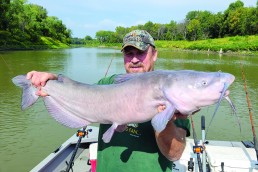Understanding the ‘Why’ of Catfish for Better Success
SHARE THIS POST
Capt. Brad Durick explains the “why” of catfish is the key to success in catching them.
A few years back, I had some new guests and the fishing was going very well. In fact,the clients noticed that our catch rates were nearly triple of that of any boat we could see this day. They asked why we were catching so many more fish than the rest of the anglers in our area while it seemed we were doing nothing different.
At first, my response was, “I know the why.” The bite had been very specific to a very shallow current seam. We were fishing a fairly narrow section of river with very few midriver holes. Other anglers were finding and setting up on those holes. They were catching fish, but they were not catching near the numbers that we were.
I had deduced that the fish were migrating during the night into a fast pool to gorge, then coming back downstream during the day to rest. Because they had been gorging all night, they were not actively hunting during the day. That is the why. What we were doing is sitting just off the current on the off current seam and casting shallow from the off current seam to the bank. In such a narrow section of river, it was so subtle that nobody noticed that little difference.
Another thing we were doing is moving a lot—sometimes within ten minutes of setting up, and other times about 20 minutes after setting up, but never staying much more than that. Why? Because the fish were not actively feeding, we had to go to them.
Our second strategy was to pull a few fish from an area and make a small move to new fish. Sometimes we would go 20 to 30 yards. Other times, we would run into a bend and faster water, and had to jump to the other side of the river to find slower water. This was an example of knowing why fish were doing what they were doing, which paid huge dividends.
Another time when knowing the why can pay big dividends is later in fall, when the water temps are coming down and there are average days with cooler nights. This is a trigger to catfish to begin moving into fall season patterns. We basically fished the exact same way as the previous example, but the why is different.
Are you enjoying this post?
You can be among the first to get the latest info on where to go, what to use and how to use it!
Catfish do not need to eat as much when the temperature is dropping as fall sets in. They are still using the same holes within a river, but because they do not have to eat as much to survive and grow, they do not wish to expend unnecessary energy if they can help it. In this case, you would set up on the off current side of the hole and extend your sit times to allow fish that are not needing to feed to find your baits. Once you have the current seam and the preferred depth figured out, you can replicate the pattern all day long.
Those two situations explained when you knew why the fish are not aggressively feeding. At the other end of the spectrum, what about when you show up and the fish are on fire? Sometimes, the why to this is simply the time of year and the need to feed, such as during the pre-spawn period.
Setting pre-spawn aside, some days, with little to no warning, catfish just decide to feed. What is going on, and why is this suddenly happening? One of two easy explanations can answer this question. The first is, the conditions are very stable and the fish simply feel good and want to get out and feed. The second is, there could be an impending weather front on the way and the fish sense that they must prepare for a negative downturn in feeding conditions.
Most anglers have a handle on where and how they like to fish. Some will change lures and baits until they run out of time trying to get fish to bite. Others will use their electronics and drive from end to end of the lake or river, looking for the right fish. Understanding the fish you are targeting, the why of what they do, and why they do it will put you in a great place for success.
If you enjoy catfishing, you’ll find suggestions for locations and techniques in every issue of MidWest Outdoors, available by subscribing on our website.
MWO
SHARE THIS POST
You may also like...
Nothing found.
Did you enjoy this post?
You can be among the first to get the latest info on where to go, what to use and how to use it!
Brad Durick
Captain Brad Durick is a nationally recognized catfish guide, seminar speaker, and author of the books Cracking the Channel Catfish Code and Advanced Catfishing Made Easy. For more information: redrivercatfish.com or facebook.com/braddurickoutdoors.
